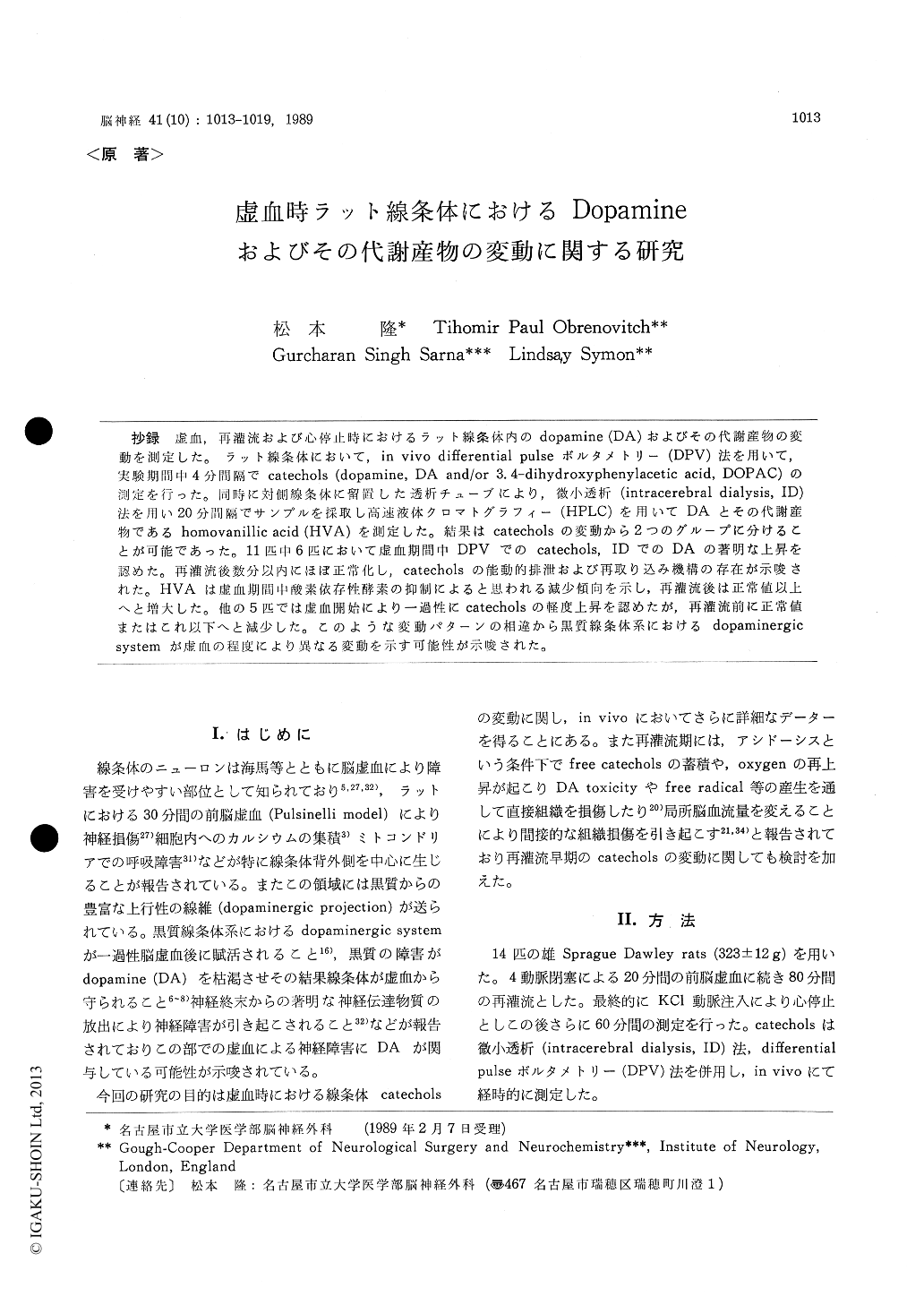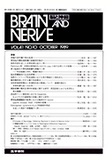Japanese
English
- 有料閲覧
- Abstract 文献概要
- 1ページ目 Look Inside
抄録 虚血,再灌流および心停止時におけるラット線条体内のdopamine (DA)およびその代謝産物の変動を測定した。ラット線条体において,in vivo differential pulseボルタメトリー(DPV)法を用いて,実験期間中4分間隔でcatechols (dopamine, DA and/or 3.4-dihydroxyphenylacetic acid, DOPAC)の測定を行った。同時に対側線条体に留置した透析チューブにより,微小透析(intracerebral dialysis, ID)法を用い20分間隔でサンプルを採取し高速液休クロマトグラフィー(HPLC)を用いてDAとその代謝産物であるhomovanillic acid (HVA)を測定した。結果はcatecholsの変動から2つのグループに分けることが可能であった。11匹中6匹において虚血期間中DPVでのcatechols, IDでのDAの著明な上昇を認あた。再灌流後数分以内にほぼ正常化し,catecholsの能動的排泄および再取り込み機構の存在が示唆された。HVAは虚血期間中酸素依存性酵素の抑制によると思われる減少傾向を示し,再灌流後は正常値以上へと増大した。他の5匹では虚血開始により一過性にcatecholsの軽度上昇を認めたが,再灌流前に正常値またはこれ以下へと減少した。このような変動パターンの相違から黒質線条体系におけるdopaminergicsystemが虚血の程度により異なる変動を示す可能性が示唆された。
Many data suggest that the presence of dopa-mine (DA) is a prerequisite for the development of neuronal damage in the striatum ; neural injury could be initiated by a massive release from dopa-minergic nerve terminals during ischemia. The current study was undertaken in order to define the mechanism through which ischemia alters do-paminergic neurotransmission, and to examine the subsequent events early during recirculation.
Experiments were performed on 14 male anes-thetized Sprague Dawley rats. The ischemic in-sult consisted of 20 min global cerebral ischemia (4-vessel occlusion) followed by 80 min reperfusion. Cardiac arrest concluded this phase of the experi-ment, but measurements were continued for 60 min more. Measurements of catechols were made in the striatum using in vivo differential pulse volta-mmetry (DPV), each 4 min, throughout the experi-ment and for 60 min post-mortem. DPV data were substantiated with intracerebral dialysis ; 20 min dialysate samples were analysed for dopamine (DA) and homovanillic acid (HVA ; DA metabo-lite) using high performance liquid chromato-graphy (HPLC). Repeated in vivo DPV measure-ments of striatal catechols during ischemia/reperfu-sion were collected in 11 of 14 experiments. In 6 out of 11 rats, ischemia induced a massive catechols release in the striatum, resulting in a marked increase in extracellular level (350 to 1200% of control), which persisted throughout ischemia. In these rats, a marked rise in extracellular DA was detected in the dialysate sample collected in the contralateral striatum during ischemia, together with a fall in HVA, probably due to ischemic in-hibition of the enzymatic oxidation of DA. Cate-chol was cleared from the extracellular space with-in minutes of reperfusion, indicating functional ca-techol uptake. In 5 rats only a relatively small and transient catechol increase was detectable, cle-ared before the end of ischemia, probably reflect-ing less severe ischemia. DPV revealed a much increase in the catechol peak immediately after ca-rdiac arrest. Also dialysis data showed a massive increase of DA in the striatal extracellular space. These increse were seen in all rats, including the 5 which had shown little response to ischemia. In-tracerebral dialysis data obtained in the current study clearly demonstrated that the rise in DPV peak 2 (catehol) represented a massive DA release, associated with a decrease in HVA. DA release in the striatum can result either from an intensifi-cation of the firing of dopaminergic neurones in the substantia nigra, or from a direct effect on stri-atal synaptosomes. In our massive DA released group (6 rats), the magnitude of the DA release and the fact that intense firing of substantia nigra neurones could not be sustained in ischemic condi-tions, rather support the hypothesis of a direct effect of ischemia on dopaminergic terminals. Although other 5 rats did not show a massive rise in the catechol peak during ischemia, they did so immediately after death. This suggests that ische-mia had not been severe enough. The small size of the increase in DPV peak 2, its transient aspect and the fact that it returned to slightly below nor-mal during ischemia, suggest that it could have resulted from a temporary intensification of the firing of doperminergic neurones in the substantia nigra, subsiding to electrical silence as energy ran out.

Copyright © 1989, Igaku-Shoin Ltd. All rights reserved.


